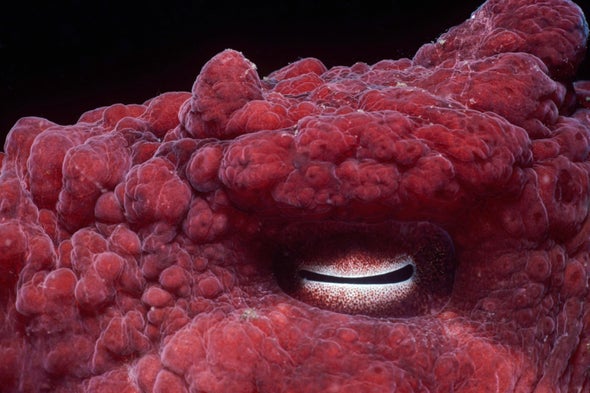The first eyes probably appeared long before the Cambrian explosion that occurred from 541 million to 530 million years ago. Some of the earliest renditions might have been a simple pit eye, a kind of pit of tissue lined with light receptors, or what scientists call an eyespot, a simple region that detects light. Over time, new anatomy appeared. Lenses and corneas, which bend and focus light, developed, with the latter taking on special importance for organisms living on land. “The cornea, which in fish is simply a transparent protective cover for the eye, became an image-forming structure in its own right,” wrote the late Michael Land, a biologist at the University of Sussex in England, in a 2005 study in the journal Current Biology, “because it now had air on one side and water on the other.”
Some organisms have kept basic structures—flatworms and mollusks still have their simple pit eyes—while others sprouted mirrored components, elaborate pupil dynamics and arrangements that let their owner see above and below a waterline simultaneously. Even in animals that rely primarily on sensations besides sight, incredible eye features persist. Below are a handful of peepers from across the animal kingdom. A few resemble our own, and some have capabilities you may wish you had, too.
Chris Mattison Alamy
" data-embiggen="0" data-imageurl="https://static.scientificamerican.com/sciam/assets/Image/2021/SII/EYES/2_FW_W7T2WK.jpg" data-imagewidth="" data-inited="true" data-instanceid="AF186A13-EE05-4F26-BC0E628BCF4488C5" data-layout="inline" data-object="infographic" data-objecticonclass="mi-picture-o" data-objectid="A4BE14C2-CCDF-4291-9BE40883A2A2AB3B" data-objectname="Infographic / Inline Image" data-panzoom="0" data-summary="" data-title="" style="">
Mossy New Caledonian gecko is the largest gecko species ever recorded—individuals grow up to 14 inches long. Like some of its fellow nocturnal relatives, it will slap its tongue up to its eye to wipe grime away.
Andrey Nekrasov Alamy
" data-embiggen="0" data-imageurl="https://static.scientificamerican.com/sciam/assets/Image/2021/SII/EYES/3_FW_GH73NH.jpg" data-imagewidth="" data-inited="true" data-instanceid="721AB186-B11F-4D56-A8854038EC9A6F88" data-layout="inline" data-object="infographic" data-objecticonclass="mi-picture-o" data-objectid="D624C9E9-8AD1-4AF5-A1EA720A30E1249A" data-objectname="Infographic / Inline Image" data-panzoom="0" data-summary="" data-title="">
The silvery glow circling this bigfin reef squid’s eye likely comes from two structures: cells full of tiny plates that reflect light and legions of tiny, pigmented organs that cephalopods selectively contract or relax.
WaterFrame Alamy
" data-embiggen="0" data-imageurl="https://static.scientificamerican.com/sciam/assets/Image/2021/SII/EYES/4_FW_BH93MJ.jpg" data-imagewidth="" data-inited="true" data-instanceid="FAE83EE6-3204-4544-A8F51D5A6D8B6B49" data-layout="inline" data-object="infographic" data-objecticonclass="mi-picture-o" data-objectid="3C815F64-1ACA-4618-901F09061714CB40" data-objectname="Infographic / Inline Image" data-panzoom="0" data-summary="" data-title="" style="">
Atlantic nurse shark: The suction feeder gets shut-eye during the day and lies still while snoozing—making it the only shark species that shows multiple attributes of what the rest of the animal kingdom calls “sleep.”
David Fleetham Alamy
" data-embiggen="0" data-imageurl="https://static.scientificamerican.com/sciam/assets/Image/2021/SII/EYES/5_FW_AXW38.jpg" data-imagewidth="" data-inited="true" data-instanceid="17F943A7-43C8-4C78-A8F3CBA980F934AB" data-layout="inline" data-object="infographic" data-objecticonclass="mi-picture-o" data-objectid="84B62B20-018C-4EEE-90C145EFA67E2FB3" data-objectname="Infographic / Inline Image" data-panzoom="0" data-summary="" data-title="" style="">
Coral-boring scallop: The pictured 11 eyes in this mollusk don’t focus light with lenses like most animals’ peepers do. These eyes use reflective crystals—also found in carp scales and chameleon skin—to gather and direct the rays.
Christopher Swann Science Source
" data-embiggen="0" data-imageurl="https://static.scientificamerican.com/sciam/assets/Image/2021/SII/EYES/6_FW_SS2761393.jpg" data-imagewidth="" data-inited="true" data-instanceid="A76A4D20-4C73-4819-8840BE69B66973DD" data-layout="inline" data-object="infographic" data-objecticonclass="mi-picture-o" data-objectid="A099C74D-22B7-4296-87C914244C6527BB" data-objectname="Infographic / Inline Image" data-panzoom="0" data-summary="" data-title="">
Gray whale: As most cetaceans cope with changing light intensity as they return to the surface after a dive, their pupils contract from a circle to a bean-shaped crescent at the bottom of the eye and then to a faint crescent connecting two tiny holes.
Anna Om Getty Images
" data-embiggen="0" data-imageurl="https://static.scientificamerican.com/sciam/assets/Image/2021/SII/EYES/7_FW_690897154.jpg" data-imagewidth="" data-inited="true" data-instanceid="915CB3A9-CAED-40AD-ABD1CFB96551B011" data-layout="inline" data-object="infographic" data-objecticonclass="mi-picture-o" data-objectid="E3FFF29F-D85F-42C8-8723326F60849BC7" data-objectname="Infographic / Inline Image" data-panzoom="0" data-summary="" data-title="">
Parrot: Although light in the ultraviolet range lies outside the boundaries of what humans detect, birds can see these wavelengths, which play a role in their mating and food-finding habits.
Paulo Oliveira Alamy
" data-embiggen="0" data-imageurl="https://static.scientificamerican.com/sciam/assets/Image/2021/SII/EYES/8_FW_R1GRFK.jpg" data-imagewidth="" data-inited="true" data-instanceid="2107FF07-B0C1-423D-89236F0B5E9418DC" data-layout="inline" data-object="infographic" data-objecticonclass="mi-picture-o" data-objectid="F813D3D4-C521-419C-8F395189BAB7D261" data-objectname="Infographic / Inline Image" data-panzoom="0" data-summary="" data-title="">
Four-eyed fish: A single eye in this species—pictured here—holds two lobes. One sits above the waterline, and one sits below it, lending the “four-eyed” moniker to a fish that cruises the water’s surface for floating snacks.
Mihai Andritoiu Alamy
" data-embiggen="0" data-imageurl="https://static.scientificamerican.com/sciam/assets/Image/2021/SII/EYES/9_FW_RE72EN.jpg" data-imagewidth="" data-inited="true" data-instanceid="A7006FE2-EFC5-4EC6-8EE17878AB58BA94" data-layout="inline" data-object="infographic" data-objecticonclass="mi-picture-o" data-objectid="8FAC6672-7984-4FEE-A1ABCE849FD8D844" data-objectname="Infographic / Inline Image" data-panzoom="0" data-summary="" data-title="" style="">
Wood louse spider: This species belongs to a relatively small number of spiders that have six eyes instead of eight. They lack the “principal eyes,” which convey color vision and higher spatial acuity in most species.
Steve Bloom Images Alamy
" data-embiggen="0" data-imageurl="https://static.scientificamerican.com/sciam/assets/Image/2021/SII/EYES/10_FW_AFMWAD.jpg" data-imagewidth="" data-inited="true" data-instanceid="E3ED5FA5-3F03-4963-B2ECB0D77654F36E" data-layout="inline" data-object="infographic" data-objecticonclass="mi-picture-o" data-objectid="50BE6A8E-2A70-4B75-8AC8A65E9AF678D6" data-objectname="Infographic / Inline Image" data-panzoom="0" data-summary="" data-title="">
Indian elephant: Dissections of elephant eyes show that during the day, the gentle giants likely have red-green color blindness just like some humans, meaning they can’t distinguish the two colors.
mikroman6 Getty Images
" data-embiggen="0" data-imageurl="https://static.scientificamerican.com/sciam/assets/Image/2021/SII/EYES/11_FW_579512004.jpg" data-imagewidth="" data-inited="true" data-instanceid="ABEFEC44-8F31-457C-84FF3732B2173E59" data-layout="inline" data-object="infographic" data-objecticonclass="mi-picture-o" data-objectid="F7C81A1E-0852-4F3A-93E48B6920A74CC7" data-objectname="Infographic / Inline Image" data-panzoom="0" data-summary="" data-title="" style="">
Horsefly: These flies are attracted to polarized light, or rays of light that vibrate in the same direction. Females find prey by locking in on polarized beams coming off its hair.
Sebastian Janicki Alamy
" data-embiggen="0" data-imageurl="https://static.scientificamerican.com/sciam/assets/Image/2021/SII/EYES/12_FW_H71BMR.jpg" data-imagewidth="" data-inited="true" data-instanceid="80FA0BB8-EB5C-4596-8E702998BF5AD9B5" data-layout="inline" data-object="infographic" data-objecticonclass="mi-picture-o" data-objectid="820C8964-CCB4-47F4-A030BAB53937ECC2" data-objectname="Infographic / Inline Image" data-panzoom="0" data-summary="" data-title="" style="">
Tokay gecko: When this slit pupil constricts, the scalloped edges merge to make four diamond-shaped pinholes and four images of an object within the gecko’s retina. Whether the images converge into one depends on how far away they are, which probably helps the reptile gauge distance.
Bruce Shafer Science Source
" data-embiggen="0" data-imageurl="https://static.scientificamerican.com/sciam/assets/Image/2021/SII/EYES/13_FW_SS2900044.jpg" data-imagewidth="" data-inited="true" data-instanceid="C32293EC-1A88-428F-9056759ACF0687A0" data-layout="inline" data-object="infographic" data-objecticonclass="mi-picture-o" data-objectid="47BC6495-D5A4-4DB1-970191BAA1EEB706" data-objectname="Infographic / Inline Image" data-panzoom="0" data-summary="" data-title="">
Crocodile fish: As the species lurks around sandy ocean floors, the iris lappet, or lacey covering drooping over its eye, obscures the pupil and improves fish’s overall camouflage.
A version of this article with the title “Science in Images” was adapted for inclusion in the August 2021 issue of Scientific American.

